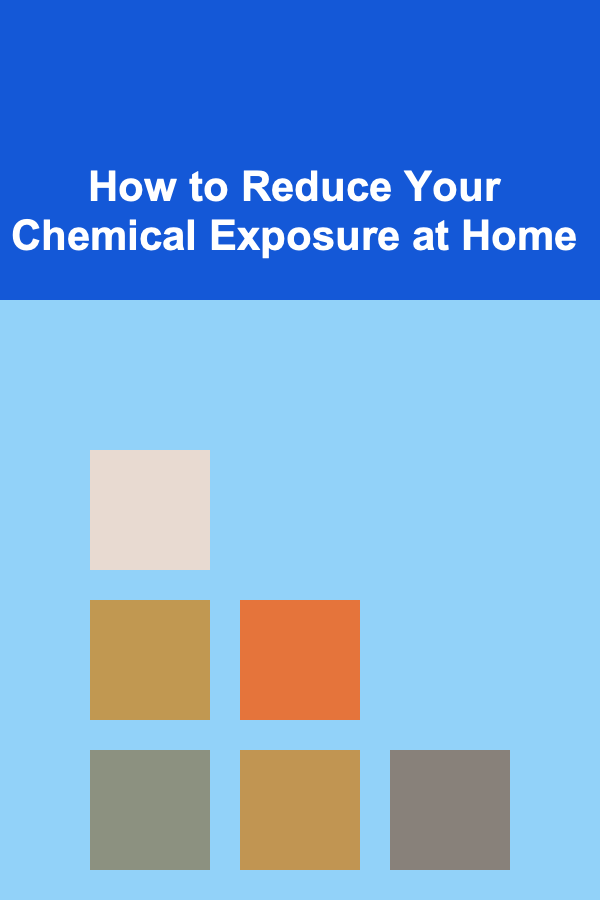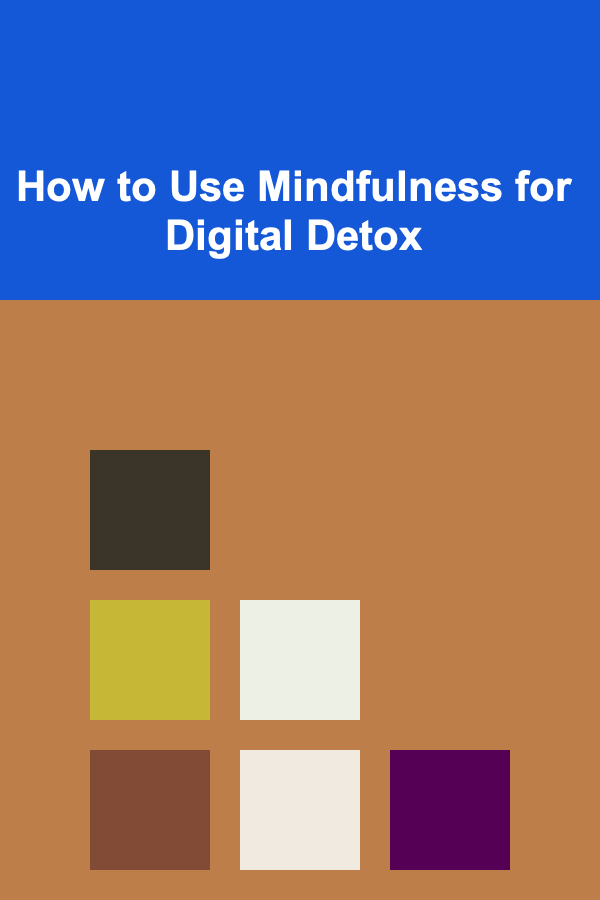
How to Reduce Your Chemical Exposure at Home
ebook include PDF & Audio bundle (Micro Guide)
$12.99$5.99
Limited Time Offer! Order within the next:

In our modern world, chemicals are everywhere --- from cleaning supplies and personal care products to the materials used in our homes. While these substances can make our lives more convenient, many of them can also pose serious health risks, especially when we are exposed to them over time. Whether it's through skin contact, inhalation, or ingestion, the chemicals in everyday products can have cumulative effects on our health. Reducing chemical exposure at home is an essential step toward creating a safer and healthier living environment for you and your family.
In this article, we'll explore ways to minimize your chemical exposure at home, focusing on practical and sustainable changes you can make. By being mindful of the products you use, the materials in your home, and the air you breathe, you can significantly reduce your exposure to harmful substances and protect your health in the long run.
Why Is Reducing Chemical Exposure Important?
Before delving into how to reduce chemical exposure, it's important to understand why it matters. Chemicals in the home can come from a variety of sources, including:
- Cleaning products: Many commercial cleaning agents contain toxic chemicals that can irritate the skin, eyes, and respiratory system. Over time, these chemicals can accumulate in your home and cause long-term health issues.
- Personal care products: Cosmetics, shampoos, soaps, and deodorants often contain harmful chemicals such as parabens, phthalates, and artificial fragrances that can interfere with hormone function and potentially lead to more serious health conditions.
- Household furnishings: Furniture, carpets, and paint can release volatile organic compounds (VOCs) into the air, contributing to indoor air pollution and causing respiratory issues or headaches.
- Pesticides and herbicides: These chemicals are used in homes and gardens to control pests and weeds, but they can pose risks to human health if not handled properly.
- Plastics and synthetic materials: Many plastics contain BPA (bisphenol A), phthalates, and other harmful chemicals that can leach into food or beverages and be absorbed through the skin.
The Risks of Long-Term Chemical Exposure
Long-term exposure to these chemicals has been linked to various health problems, including:
- Hormonal disruption: Many chemicals found in household products can mimic or interfere with hormones in the body, leading to imbalances that may cause issues such as fertility problems, early puberty, or developmental delays.
- Respiratory issues: VOCs and other airborne chemicals can irritate the lungs and exacerbate conditions like asthma, allergies, or chronic bronchitis.
- Cancer: Some household chemicals, like formaldehyde, benzene, and certain cleaning agents, are classified as carcinogens and have been linked to an increased risk of cancer with long-term exposure.
- Neurological effects: Studies have suggested that exposure to certain chemicals, such as heavy metals and solvents, can impair brain function and lead to cognitive decline or behavioral problems.
- Skin irritations and allergies: Many chemicals in personal care and cleaning products can cause skin reactions, including rashes, hives, or eczema.
By making informed decisions and reducing your exposure to these harmful chemicals, you can reduce the risk of these health issues and create a safer environment for your family.
Practical Steps to Reduce Chemical Exposure
1. Switch to Non-Toxic Cleaning Products
Cleaning products are some of the most common sources of chemical exposure in the home. Many commercial cleaners contain harmful ingredients such as ammonia, bleach, and phthalates. To reduce exposure, consider switching to natural cleaning alternatives:
- Baking soda: A versatile and effective cleaner that can be used to scrub surfaces, eliminate odors, and even unclog drains.
- Vinegar: A natural disinfectant and deodorizer, vinegar can be used for cleaning windows, countertops, and bathroom surfaces.
- Essential oils: Many essential oils, such as lavender, tea tree, and lemon, have natural antibacterial properties and can be used to add fragrance and disinfect surfaces.
- Castile soap: A plant-based soap that can be used for a variety of cleaning tasks, from washing dishes to cleaning floors.
You can also make your own cleaning products at home using ingredients like vinegar, baking soda, and lemon juice, all of which are safe, affordable, and effective.
2. Opt for Natural Personal Care Products
Personal care products, such as shampoos, lotions, deodorants, and makeup, often contain chemicals that can be absorbed through the skin. To reduce chemical exposure, consider switching to natural and organic alternatives that are free from harmful ingredients. Look for products that are:
- Paraben-free: Parabens are preservatives used in cosmetics and personal care products, but they have been linked to hormone disruption. Choose products labeled "paraben-free."
- Fragrance-free or naturally scented: Many synthetic fragrances contain phthalates, which can interfere with hormone function. Opt for products with natural scents from essential oils or choose fragrance-free options.
- Sulfate-free: Sodium lauryl sulfate (SLS) is a common detergent in personal care products that can irritate the skin and scalp. Look for sulfate-free shampoos and soaps.
- Cruelty-free: In addition to being mindful of the ingredients, consider choosing brands that are cruelty-free and not tested on animals.
For skincare, consider using natural oils such as coconut oil, olive oil, or jojoba oil, which are gentle and effective for moisturizing and nourishing the skin.
3. Use Natural Pest Control Methods
Pesticides and herbicides are common household chemicals used to control pests and weeds, but they can be toxic to humans and pets. Instead of relying on chemical pest control, opt for natural alternatives:
- Diatomaceous earth: A non-toxic powder that can be sprinkled in areas where pests are a problem. It kills insects by dehydrating them without harming humans or pets.
- Essential oils: Many essential oils, such as peppermint, eucalyptus, and citronella, can act as natural repellents for insects. You can create your own spray by diluting the oil in water and spraying it around your home.
- Physical barriers: Install screens on windows, use sealed containers for food storage, and seal cracks and gaps in the walls to prevent pests from entering your home.
For gardening, consider using organic fertilizers and weed control methods, such as mulching and hand-weeding, rather than relying on chemical pesticides.
4. Choose Non-Toxic Building Materials and Furniture
The materials used in your home can also contribute to chemical exposure. Furniture, carpets, and paint can release VOCs into the air, affecting indoor air quality. To minimize exposure, consider the following:
- Low-VOC or VOC-free paints: Traditional paints can release harmful VOCs into the air, which can contribute to respiratory issues. Choose paints that are labeled as low-VOC or VOC-free to minimize exposure.
- Natural flooring materials: Instead of synthetic carpets or vinyl flooring, opt for natural materials such as hardwood, bamboo, or cork. These materials are less likely to emit harmful chemicals.
- Formaldehyde-free furniture: Many furniture pieces, especially those made from particleboard or MDF (medium-density fiberboard), contain formaldehyde, a known carcinogen. Look for furniture made from solid wood or items labeled as "formaldehyde-free."
5. Improve Indoor Air Quality
Indoor air quality is often worse than outdoor air quality due to the buildup of chemicals and pollutants in the home. To reduce exposure to airborne toxins:
- Ventilate your home: Open windows regularly to allow fresh air to circulate and reduce the concentration of indoor pollutants.
- Use an air purifier: Invest in a high-quality air purifier with a HEPA filter to remove dust, allergens, and VOCs from the air.
- Houseplants: Certain houseplants, such as spider plants, peace lilies, and snake plants, can help purify the air by absorbing pollutants.
6. Choose Safer Plastics or Avoid Them Altogether
Plastics can contain harmful chemicals such as BPA, phthalates, and PVC, which can leach into food and beverages, particularly when heated. To reduce exposure to plastic toxins:
- Avoid plastic containers for food storage: Opt for glass, stainless steel, or BPA-free plastic alternatives.
- Avoid microwaving food in plastic: Heating plastic can cause harmful chemicals to leach into food. Use glass or ceramic containers for microwaving instead.
- Switch to natural fibers: For clothing, bedding, and other textiles, choose natural fibers like cotton, wool, and linen, which are less likely to contain harmful chemicals than synthetic fabrics.
7. Educate Yourself and Make Informed Choices
The best way to reduce chemical exposure is to become informed about the products you are using. Read labels carefully and avoid products with ingredients that you cannot identify or pronounce. Research alternatives, and choose products that are natural, organic, and non-toxic.
Conclusion
Reducing your chemical exposure at home is an essential step toward promoting your health and the health of your family. By making simple and informed choices about the products and materials you use, you can create a safer living environment. Whether it's switching to non-toxic cleaning products, opting for natural personal care items, or choosing safer building materials, every small change can have a significant impact on your overall well-being. By taking control of your home environment, you are investing in a healthier, more sustainable future.

How to Create a Color-Coded System for Your Supplies
Read More
How to Stage Your Living Room to Maximize Space
Read More
How to Turn an Old House into a Modern Home
Read More
Optimizing Healthcare Systems: Strategies and Solutions for Healthcare Consultants
Read More
How to Use Mindfulness for Digital Detox
Read More
How to Create a Culturally Rich Home Environment
Read MoreOther Products

How to Create a Color-Coded System for Your Supplies
Read More
How to Stage Your Living Room to Maximize Space
Read More
How to Turn an Old House into a Modern Home
Read More
Optimizing Healthcare Systems: Strategies and Solutions for Healthcare Consultants
Read More
How to Use Mindfulness for Digital Detox
Read More